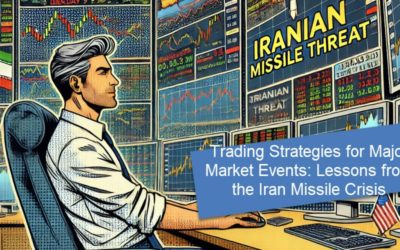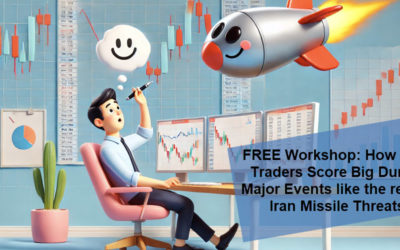My $6,000 mistake – avoiding the 6 most costly errors with trade rooms
Trade rooms, where subscribers pay to watch somebody trade live online, seem like the perfect education tool. I speak to a lot of traders looking for mentors who say, “if only I could watch somebody trade, THEN I’d get it”. You aren’t alone, in fact, this way of thinking cost me $6,000. More on that later.
You’d be forgiven for presuming that “watching them trade live” is what happens in professional trading firms. In proprietary trading firms (prop shops), trainee traders don’t get access to the traders making the big bucks. There are a few reasons for this. First of all, prop traders get a share of the profits, there’s usually no salary. A trainee would love nothing more than to trap a profitable trader in the office kitchen and ask them a hundred questions. That would probably end in bloodshed, as you don’t stand between a man and his trading desk. A lot of prop firm interns simply don’t make it as traders, the profitable traders in the firm know this and don’t want to spend time helping people who may decide trading is not for them.
The upshot is that if you join a prop firm, you’d be lucky to make eye contact with the best traders there. Make some profits though, and you’ll find they’ll be a lot more helpful and friendly.
If professional traders don’t need to watch somebody trade to become profitable, why do you?
My Trade Room nightmare.
Many years ago, I decided I wasn’t happy with the accuracy of my trading. I searched high and low until I stumbled upon a website claiming to have the answers. The site offered a method of reading charts that was unique. You got the method and the chance to watch our hero “Brian” trade the method in a live room for as long as you wanted. “Will you be trading a live account?” I asked, “Yes” I was told. “Will I be able to see your DOM as you enter and exit the market”, again I was told “Yes”.
Well, that was exactly what I was looking for. A profitable, professional trader promising to share his secrets. I paid my $6,000 and started my first day in the room. The results weren’t very inspiring on the first few days. The first week went by, and the results were poor. He was losing, but not much. OK – we can all have our bad weeks. As we went on, I brought up my charts and started to watch the order flow while he was trading. Sometimes, it was the most I could do to not type “Noooooooo – don’t go long here” because he was trading against strong momentum, but he wasn’t paying any attention to the flow of trade.
By week 4, I was pretty annoyed. After one amazingly bad trade, I just typed in the room “Dude, you suck” and told him he should really stop trading. I realized a couple of things at that point. Firstly, I was actually a much better trader than he was. Secondly, he’d been given $60,000 between me and the other room members, and we were paying to watch him lose our money.
He was never a profitable trader, I guess he just figured he might make it if he found 10 suckers to give him $6,000 each.
On the bright side, this was the last time I ever paid anyone any money for trading education. The lesson I needed was that I was really doing OK. I just needed to see someone trade badly to understand that.
So, here are 6 things you need to know about trade rooms.
1 – The industry is unregulated. That means that anyone can set up a trade room regardless of whether they can trade or not. As many of them don’t show their trading DOM, you don’t know whether they are trading a real account or not. Many trade rooms are simply fake. The CFTC has started to crack down a little bit, but you do have to be pushing the boundaries to commit an offense. Fake performance records can have the CFTC knocking on your door, but if you don’t show ANY performance records, and you put a disclaimer on your site, you can run a lousy trade room without fear.
2 – Trade rooms can be a crutch that prevents you from developing. You can’t replicate somebody else’s technique exactly. There will always be a ‘little bit of you’ in the way you trade. At some point, you’ll have to stand on your own two feet as a trader. Every profitable trader I know trades in their own way. They are the sum total of their trading experience (including education). That will apply to the person running your trade room too, they will be unique. You can’t become them. Traders understand how the market behaves, they see behavior, and they trade it. Some things will feel easy to one person, but hard to another. Many traders have the goal of “I want to click when you click” – to be a carbon copy trader, which prevents thinking and development.
3 – If you convince yourself a trade room is necessary for your success – it will be. As most trade rooms are useless, you’ll be in a position where your success is dependent on something you can’t find. At the very best, a trade room should be ‘nice to have.
4 – It is very difficult to run a trade room. If you are trading live, it’s hard to describe everything you see and all the decisions you are making in real-time. You need to “think out loud” but thinking is much faster than talking. You might be trying to describe the last thing you saw when something else important occurs. You can’t help but miss stuff out.
5 – It is very hard to watch a trade room. Whenever the trader says something, it will be about what he’s just seen. In many cases, what he’s seen won’t be visible anymore. He’ll have had his eye on something but when he describes it to you, you will only then start to look at it – after it’s gone!
6 – Trade rooms are theoretical, not practical. Many people think that trade rooms give them experience. This is not true. Trade rooms help build your theoretical knowledge, but that does not represent actual trading experience. At some point, you need personal experience to grow.
Prop firms get their trainees to learn with drills. They will tell you how the markets work, they will give you theory. They will even show you trade videos. But then they’ll give you trading drills. Exercises that you perform on a live market to give you practical experience. They will have you sitting down in front of a screen performing these drills till your eyes bleed. They will have you experiencing the market on your own. They will have you watching the right things at the right time until the markets make sense to you.
Not all trade rooms are bad. They just can’t replace actual experience. If you use a trade room as a development tool, taking from it what you need, understanding that ultimately you need to become your own trader, then you should be fine. Use a trade room as a trading crutch, and you’ll never improve.
Are trade rooms necessary, though? Well, if a professional trader can learn without one, then so can you. If you don’t believe me, ask the guy running the trade room which trade room he used to learn from!
Simplify Your Trading
Take a look into the decision making process of professional traders with this video training series that helps you make smarter trading decisions.




0 Comments